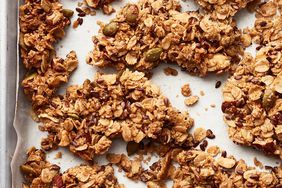
Bryan Gardner
Overnight oats just get more popular—and for good reason. They're a healthy and filling breakfast that everyone loves. Overnight oats are a meal prep standard in our kitchens for a few reasons: they’re portable and make a great on-the-go breakfast; you can create them up to a few days ahead of time; and they are so versatile. You can make them as sweet or creamy as you’d like and add any of your favorite toppings.
Unlike oatmeal, overnight oats don't require any cooking time. Old-fashioned rolled oats are allowed to soak in milk until they soften to a consistency that is perfectly pleasant to eat. They're easy to make, but there are a few points where things can go wrong. Here, we're sharing the mistakes to avoid, plus our tips and tricks to ensure your overnight oats have the perfect consistency and flavor. They’ll be a regular part of your make-ahead breakfast rotation in no time.
How to Make Overnight Oats
It really is as easy as stirring together a few key ingredients and then letting the oats hang out in the refrigerator overnight.
- The key to overnight oats is the correct milk-to-oats ratio: for each cup of rolled oats, you'll want to use ¾ cup of milk. Cow’s milk or any plant-based milk alternative works, so use whatever you like best (just avoid using water in place of milk since the oats won’t absorb the liquid as thoroughly).
- You can add a splash of sweetener, like maple syrup or honey, to the mixture or stir in a spoonful of brown sugar to add sweetness.
- Warming spices like cinnamon and nutmeg can also add a boost of flavor, depending on what you plan to serve the oatmeal with for breakfast.
The Difference Between Overnight Oats and Oatmeal
The key differences between overnight oats and traditional oatmeal are the type of oats used and the amount of time it takes from start to finish:
Oats: Oatmeal can be made with instant, steel cut, or old-fashioned rolled oats, and each will cook for different lengths of time and require different liquid-to-oat ratios. We always recommend using the rolled variety for overnight oats. Instant oats will turn to mush if they soak for too long, and steel-cut oats will never soften quite enough, leaving you with oats that are a bit too toothsome. Rolled oats soften overnight but still maintain some of their texture.
Timing: Overnight oats really do require an overnight soak. While stovetop or baked oatmeal can take anywhere from 5 minutes to an hour, overnight oats need more time since they’re not being cooked.
5 Mistakes to Avoid When Making Overnight Oats
- Using the wrong oat-to-milk ratio: If you don't add enough milk, some of the oats will soak up all of the liquid before the rest of the oats can absorb any, creating an uneven texture. Some oats will be very soft while others might still be chewy. On the other hand, if you add too much milk the overnight oats will have a soupy oat mixture because the oats can only absorb so much liquid.
- Using instant or steel-cut oats: As mentioned, rolled oats are the perfect choice for overnight oats. Instant oats will be too mushy, and steel-cut oats are too tough and chewy.
- Not seasoning: Just because overnight oats are a sweet recipe doesn’t mean you should skip adding a pinch of salt! Salt helps bring out the natural sugars and overall flavor of the dish.
- Rushing the process: It really does take at least 12 hours to get the right texture. If you don’t give the oats enough time, they won’t properly absorb all of the milk.
- Not stirring before serving: It's normal for a thin layer of milk to float to the top of the jar you made the overnight oats in. Make sure to give the jar a good stir before serving.
3 Easy Ways to Upgrade Your Overnight Oats
Anything you would add to traditional oatmeal can be used with overnight oats.
Fruit
Fresh or dried fruit is the perfect topping for overnight oats.
Fresh: Sweet mixed berries (or just your favorite kind), sliced bananas and apples, or seasonal stone fruit like peaches can be added just before serving.
Dried: To use dried fruit like cranberries, golden raisins, cherries, and apricots, stir them in before the oats soak overnight. This will save you a bit of time in the morning—and the fruit flavors and sweetens the oats.
Nuts and Seeds
- Toasted nuts and seeds, such as walnuts, almonds, peanuts, pepitas, and hemp seeds are delightfully crunchy toppings you can add to overnight oats. (We prefer to use toasted nuts or seeds because toasting brings out their flavor and makes them crunchier, for a better contrast to the soft oats.)
- A drizzle of nut butter before serving can add a boost of protein and healthy fat.
Sweeteners
- If you want to add a burst of sweetness, consider stirring in some maple syrup, honey, or your sugar of choice—we like coconut sugar—to the oats before they soak overnight.
- Feeling decadent? A drizzle of melted chocolate or dulce de leche, or a spoonful of berry jam adds a little something special.
:max_bytes(150000):strip_icc()/riley-wofford-2018-81632856279842519548bc607969b36f.jpg)













